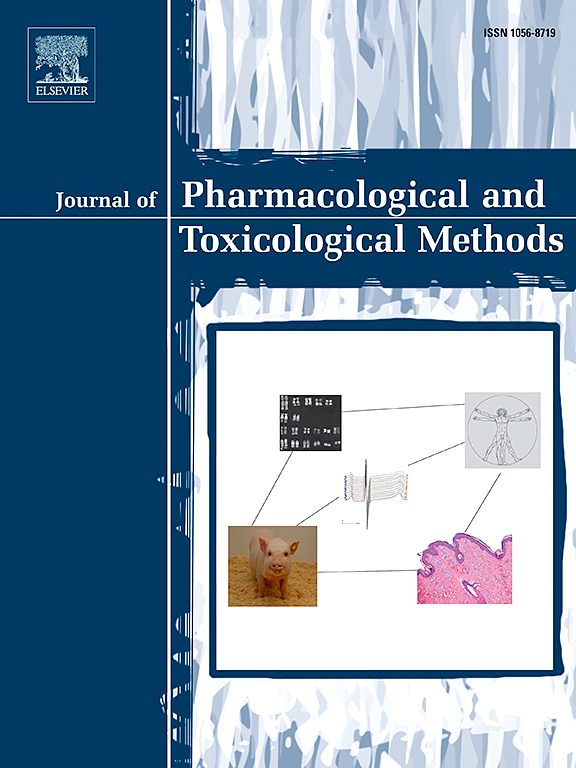基于视频的深度学习检测食蟹猴的异常行为和抽搐
IF 1.3
4区 医学
Q4 PHARMACOLOGY & PHARMACY
Journal of pharmacological and toxicological methods
Pub Date : 2025-05-01
DOI:10.1016/j.vascn.2025.107627
引用次数: 0
摘要
在非临床安全性研究中,药物引起的行为改变可能与人类的严重副作用有关,因此必须在临床试验之前检测到。我们研究了一项视频分析,使用深度学习来评估有意识的非人灵长类动物(NHPs)的运动活动(LA)和抽搐。基于每个笼子的视频数据,通过标注腰部标记来生成姿态估计的训练数据。利用基于深度学习的姿态估计模型计算二维坐标的时间序列。研究1。LA评价:给予非选择性多巴胺激动剂盐酸阿波啡(APO, 0或1 mg/kg, sc) (n = 4)。给药后4 h记录动物行为。从二维坐标系的帧差中计算动量,并在每1-h的历元中从二维坐标的过渡中创建轨迹。研究2。惊厥检测:给予戊四唑(PTZ, 60 ~ 70 mg/kg, sc), GABAA受体拮抗剂作为惊厥剂(n = 4)。记录动物在开灯或关灯(带红外辐射)条件下的行为直到抽搐发生。利用二维坐标和小波变换计算振动强度,当帧数大于阈值10秒时确定抽搐。在研究1中,观察到APO的行为变化特征(盘旋、跳跃、舔笼等)在动物间存在差异。两种NHPs的LA均有所增加,表现出与笼内盘旋或跳跃相关的不同轨迹。在研究2中,PTZ诱导所有NHPs在给药后约1小时内发生惊厥,该算法可以检测到所有动物在开灯和关灯条件下的惊厥,而该算法没有错误地检测到研究1中动物的电影文件中的任何惊厥。我们使用视频数据的深度学习模型被认为有助于评估NHPs的LA和抽搐。本文章由计算机程序翻译,如有差异,请以英文原文为准。
Detection of abnormal behavior and convulsion in cynomolgus monkeys using video-based deep learning
Drug-induced behavior changes in nonclinical safety studies could correlate to serious side effects in humans and hence must be detected prior to clinical trials. We investigated a video analysis using deep learning to assess locomotor activity (LA) and convulsions in conscious non-human primates (NHPs). The training data was created by annotating the waist landmarks for pose estimation based on the video data from each cage. The time series of 2D coordinates was calculated with the deep learning-based pose estimation model. Study 1. LA evaluation: Apomorphine hydrochloride (APO, 0 or 1 mg/kg, sc), non-selective dopamine agonist, was dosed (n = 4). Animal behaviors were recorded for 4 h after dosing. A momentum was calculated from the difference between the frames of 2D coordinates, and a trajectory was created from transition of 2D coordinates for each 1-h epoch. Study 2. Convulsion detection: Pentylenetetrazole (PTZ, 60 to 70 mg/kg, sc), GABAA receptor antagonist as a convulsant agent, was dosed (n = 4). Animal behaviors were recorded until the occurrence of convulsion under light-on or -off (with infrared radiation) condition. A convulsion was determined when the number of frames was greater than the threshold for ten seconds using 2D coordinates and vibration intensity calculated with wavelet transformation. In Study 1, behavioral changes characteristic of APO (circling, jumping, cage licking, etc.) were observed differently between animals. The LA increased in two NHPs, showing different trajectories correlated with circling or jumping in the cage. In Study 2, PTZ induced convulsions within about 1-h postdose in all NHPs and the algorithm could detect the convulsions in all animals under both light-on and -off conditions while this algorithm did not falsely detect any convulsions in movie files in the animals in study 1. Our deep learning model using video data is considered useful to assess LA and convulsion in NHPs.
求助全文
通过发布文献求助,成功后即可免费获取论文全文。
去求助
来源期刊

Journal of pharmacological and toxicological methods
PHARMACOLOGY & PHARMACY-TOXICOLOGY
CiteScore
3.60
自引率
10.50%
发文量
56
审稿时长
26 days
期刊介绍:
Journal of Pharmacological and Toxicological Methods publishes original articles on current methods of investigation used in pharmacology and toxicology. Pharmacology and toxicology are defined in the broadest sense, referring to actions of drugs and chemicals on all living systems. With its international editorial board and noted contributors, Journal of Pharmacological and Toxicological Methods is the leading journal devoted exclusively to experimental procedures used by pharmacologists and toxicologists.
 求助内容:
求助内容: 应助结果提醒方式:
应助结果提醒方式:


